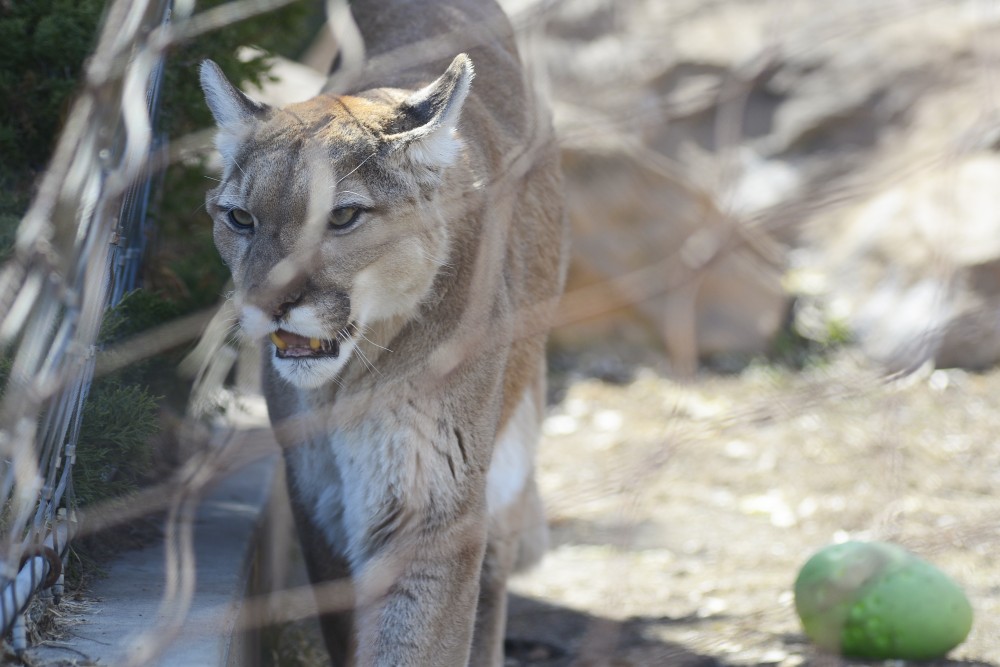As spring approaches and some in the Twin Cities start to think about visiting the Como Zoo, two new snow leopards will be there to greet them.
The snow leopards — Moutig from France and Alye from Berlin — are the latest additions to the zoo. After a three-year process to get them to St. Paul, Moutig can now be seen napping and hopping around his exhibit while Alye, who just arrived in February, will be on exhibit soon.
“She’s still getting used to her new environment,” said senior zookeeper Allison Jungheim. “Now she’s got lions near her and tigers and cougars across the way.”
With shrinking numbers in the wild, the male and female pair are part of a program to help breed and expand their population. But don’t expect a baby shower too soon.
“We hope to get little snow leopard cubs out of the deal, but it’ll probably be a year before then,” Jungheim said.
In the meantime, the rest of the animals will be thriving on the 14-acre campus, just like they have all throughout winter. Spring may bring warmer weather, but it doesn’t bring a change in schedule for the animals or staff, as Como Zoo is open every day of the year.
Each animal has an indoor area to live in during the winter, but they may choose to stay outside. Animals that enjoy the cold, like arctic foxes, reindeer and even tigers with a little winter weight can be seen roaming around outdoors in the chillier months.

This concept of choice is exactly what the zoo strives for and values, said Como Zoo’s director and campus manager, Michelle Furrer.
“People will come in and ask, ‘Why isn’t the animal on exhibit?’ Well, that’s the animal’s choice,” Furrer said. “We don’t force an animal to be on or off exhibit.”
While the public may sometimes complain about not seeing an animal, entertaining isn’t the animal’s — or the zoo’s — purpose.
“Our purpose is to help create the connection with the animals,” Furrer said.
The zoo focuses on the animals’ sustainability in both their captive and wild populations.
“These animals are the ambassadors for their wild counterparts,” Jungheim said. “So you really want to be able to have people get that empathy toward the animals and want to help out these animals both in zoos and in the wild.”
When the public can’t see the them, the animals may be enjoying some privacy or working with keepers in training sessions that teach the animals to voluntarily help the zookeepers take care of them.
Como was one of the first zoos in the country to take advantage of voluntary participation for medical purposes like blood draws and weight measurements with its polar bears.
Over the years, this training has become part of the zoo’s daily schedule for all of its animals.
“It’s important for them to be off exhibit, and the fact that we’ve been able to build these exhibits with the training aspect in mind so that we can show people what they’re doing behind the scenes really has helped out too,” Jungheim said. “They get an understanding of how much we put into the care of the animals.”
That care extends even further in the form of “enrichment items.” If visitors ever see a T-shirt in the gorilla exhibit or hear an ostrich playing with a bell, these are forms of stimulation the keepers have provided for the animals.
“We may see a toy, but for them it’s stimulating both physically and mentally,” Furrer said.
Whether it be the addition of new animals, voluntary cooperation training, engagement items or even fresh builds, like the new giraffe feeding deck last year, Furrer and Jungheim said that everything the zoo does year-round is done with the animals’ best care in mind.
“We’re not getting bigger, but getting better,” Furrer said.








